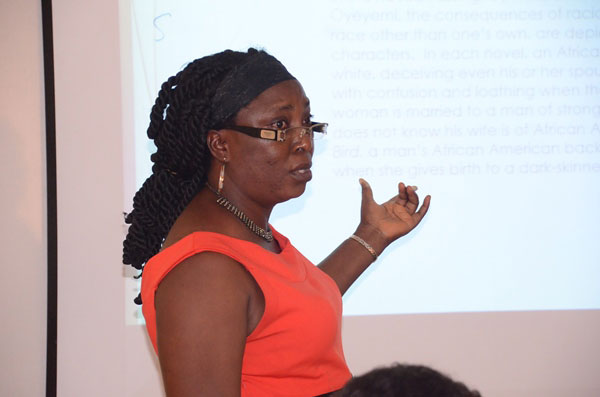Beautiful White Girlhood?: Daisy Buchanan in Nella Larsen’s Passing
African American Review
Volume 47, Number 1, Spring 2014
pages 37-49
Sinéad Moynihan, Lecturer in English
University of Exeter
This article expands recent scholarship on race in F. Scott Fitzgerald’s The Great Gatsby and intertextuality in Nella Larsen’s Passing by arguing that the latter is a “blackened” version of Gatsby. Mapping the genealogy of Passing, from Gatsby through Larsen’s first published work of fiction, “The Wrong Man” (1926), it proposes that Larsen’s allusions to Fitzgerald’s novel work to destabilize radically any secure sense of Daisy Buchanan’s whiteness by linking her quite emphatically with Clare Kendry. By reading Passing in this way, the article also reveals the extent to which Larsen built covert engagements with reading, writing and authorship into a text thematically preoccupied with looking, seeing and interpreting.
“The idea is that we’re Nordics. I am, and you are, and you are, and—” After an infinitesimal hesitation he included Daisy with a slight nod, and she winked at me again. —F. Scott Fitzgerald, The Great Gatsby (1925; emphasis added)
She couldn’t betray Clare, couldn’t even run the risk of appearing to defend a people that were being maligned, for fear that that defence might in some infinitesimal degree lead the way to final discovery of her secret. —Nella Larsen, Passing (1929; emphasis added)
In October 1927 The Forum published a debate entitled “Should the Negro be encouraged to cultural equality?” Writing in favor of the proposal was Alain Locke, one of the leading intellectuals of what was subsequently termed the Harlem Renaissance; writing against it was the nativist and eugenicist, Lothrop Stoddard. Although the thrust of Locke’s argument rests on encouraging cultural equality through white recognition of “Negro genius” as evidenced in the work of Countée Cullen, Langston Hughes and others, he anticipates Stoddard’s concern that “cultural equality” equates with interracial sex, marriage and reproduction. Locke identifies the hypocrisy of a situation by which a man who opposes “amalgamation” so passionately is the very man who “by the sex exploitation of the socially and economically unprotected Negro woman, has bred a social dilution which threatens at its weakest point the race integrity he boasts of maintaining and upholding” (Locke and Stoddard 503, 505). What is striking about Stoddard’s rebuttal is his refusal to acknowledge, as Locke does, that “amalgamation” is a fait accompli, that the amalgamation horse, if you will, had long ago bolted. For Stoddard, “the plain facts of the case” are as follows:
Since the Negroes form nearly one-tenth of the population of the United States, we are statistically light mulattos. In the last analysis, the only thing which keeps us from being biologically mulattos is the color-line. Therefore, once the principle of the color-line is abandoned, White America is doomed, and a mulatto America stands on the threshold.
(Locke and Stoddard 515)
By the term “statistically light mulatto,” Stoddard means that the American racial body (envisaged as white) is already one-tenth black. Stoddard believes that the color line must be policed rigidly if the other nine-tenths of the population are not to become “biologically mulattos,” as if America’s “white” majority were not already racially mixed. Here, Stoddard makes no admission of the possibility of what Joel Williamson terms “invisible blackness” (103): the prospect of a “black” subject’s looking, and potentially passing as, “white.”
This debate appeared halfway through the four-year interval between the publication of two apparently unconnected novels: F. Scott Fitzgerald’s The Great Gatsby (1925) and Nella Larsen’s Passing (1929). In Tom Buchanan, as several critics have noted, Fitzgerald creates a mouthpiece for the ideas of Lothrop Stoddard, especially those articulated in The Rising Tide of Color against White World-Supremacy (1920), thinly disguised in The Great Gatsby as “The Rise of the Colored Empires by this man Goddard” (Gatsby 18). Meanwhile, Larsen was not only an exemplar of “the cultural flowering of Negro talent” that Locke identifies; she was also, being of Danish and African Caribbean ancestry, the embodiment of the “hybridization” Stoddard so feared (Locke and Stoddard 507, 514). Here I consider the tissue of connections suggested by this exchange between Locke and Stoddard: between the Harlem Renaissance, contemporaneous eugenicist discourses and racial passing and, ultimately, between The Great Gatsby and Passing. This article argues that in Passing Larsen responds to both Stoddard and Tom Buchanan, that Passing is in fact a “blackened” version of The Great Gatsby. Indeed, as Thadious Davis discovers, Larsen wrote to Carl Van Vechten in 1926 of the possibility of “blackening” Francisco de Quevedo-Villegas’s novel Pablo de Segovia (1595), and it was a similar kind of literary blackening that led to the plagiarism charge leveled at her in 1930 when readers of “Sanctuary” noted the remarkable similarities between this and a story published by British writer Sheila Kaye-Smith in The Century in 1922 (Davis 165–66, 351). In fact, “Sanctuary” appeared in The Forum and Larsen was the first black writer to place fiction there. It is therefore possible, indeed likely, that she read the exchange between Locke and Stoddard. While the plagiarism charge is not my primary concern, Larsen’s engagement with Fitzgerald’s text is so obviously critical and self-conscious as to raise questions about where we draw the line between what Linda Hutcheon would term a “critical reworking” of the literary past, and one that is more uncritically derivative (4)…
Read the entire article here.

